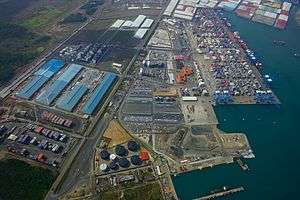Colón Free Trade Zone

The Colón Free Trade Zone is a large entity near the Atlantic entrance to the Panama Canal, located in Panama dedicated to re-exporting a wide variety of merchandise to Latin America and the Caribbean. It is a free port.
Location and size
The Colón Free Trade Zone is the largest free port in the Americas, and second largest in the world. It started operations in 1948 and occupies about 2.4 km2 (600 acres). It is divided in two large areas: one located in Colón, segregated from the city by a wall, and the other relatively new, in the harbor area, which is designated for warehouses, covering 0.53 km2 (130 acres) and 370 m (400 yards) from Colón's commercial sector.
Origins
Since 1917, three years after the opening of the Panama Canal, the possibility of a free zone in Colón was discussed. It was not, however, until the end of World War II that the idea was realized. During the war, many locals were hired to build defense facilities and facilities to provide services for the movement of troops. With the end of troop arrivals came hard times. Later, Dr. Enrique A. Jimenez, president of Panama in 1945, made the free zone project a reality, using the geographic position of the ports and the interoceanic waterway, a compulsory route for worldwide navigation. He recommended the reconsideration of a project prepared by George E. Roberts, vice president of the First National City Bank of New York, that contemplated the creation of a free zone in Colón and that had been submitted to the government in 1929.
In 1946, the government employed Dr. Thomas E. Lyons, a renowned authority on free zones, to carry out a feasibility study in the area suggested for the project. Based on his recommendations, the government approved Law No. 18 of June 17, 1948, which creates the Colón Free Zone as an autonomous institution.
Progress

Today, the Colón Free Zone receives over 250,000 visitors a year and is home to 1,751 companies. It generated exports and re-exports valued at over US$6.5 billion in 2005, which are able to harness the services and facilities offered by the free zone for importing, storing, assembling, repacking, and re-exporting products from all over the world, including electrical appliances, pharmaceutical products, liquor, cigarettes, office and home furniture, clothing, shoes, jewelry, and toys. It is considered the "trading showcase" of Central and South America, as well as of the Caribbean region.
The Colón Free Zone is an important supplier of goods to other free zones such as Hong Kong (China), Taiwan, the United States, Japan, Korea, France, Mexico, Italy, Switzerland, United Kingdom, Malaysia, and Germany. These countries supplied nearly 87% of all Colón Free Zone imports in 2004. Colombia is the largest buyer of merchandise, buying nearly 16% of the free zone's exports. Other principal buyers are Venezuela, Panama (domestic market), Guatemala, Ecuador, Costa Rica, Dominican Republic, the United States, Chile, Cuba, Honduras, Peru, Brazil, Nicaragua, and El Salvador. These countries buy approximately 83% of all exports from the Colón Free Zone. As a result, the free zone has earned the name "The First Free Zone of the Western Hemisphere".
Seaports with modern facilities, container ports, direct access through the Pan-American Highway, air access, and trains transport containers daily from the Pacific to the Atlantic Ocean. Dividends arising from external operations, or operations executed or consumed abroad, are tax free. There are no capital investment taxes. Municipal and local taxes do not apply to firms operating in the free zone, and there are no taxes on shipments to or from the free zone from or to anywhere in the world.
Issues
Exports from the free trade zone into neighboring countries are still subject to local rules, regulations, and payment requirements of the importing country. Venezuela, one of the larger buyers from the zone, has had difficulty meeting its obligations to exporters from the zone resulting in unpaid debts.[1] Colombia implemented a series of tariffs which had the effect of reducing imports, primarily from Asia.[2]
References
- ↑ El Nacional Personal (2015-03-20). "Panamá espera pago del gobierno venezolano" [Panama expects to pay the Venezuelan government]. El Nacional (in Spanish). Caracas, Venezuela. Retrieved 30 April 2016.
- ↑ Patricia Rey Mallén (2013-11-05). "Venezuela's Debt And Colombia's Tariffs Are Hurting Panama". International Business Times. Retrieved 30 April 2016.
Further reading
- Mellander, Gustavo A.; Nelly Maldonado Mellander (1999). Charles Edward Magoon: The Panama Years. Río Piedras, Puerto Rico: Editorial Plaza Mayor. ISBN 1563281554. OCLC 42970390.
- Mellander, Gustavo A. (1971). The United States in Panamanian Politics: The Intriguing Formative Years. Danville, IL: Interstate Publishers. OCLC 138568.
See also
External links
| Wikimedia Commons has media related to Colón Free Trade Zone. |
- "Duty Free B2B. Search. Find. - colonfreezone.com - Trade Leads, Information and Business". colonfreezone.com. Retrieved 30 April 2016.